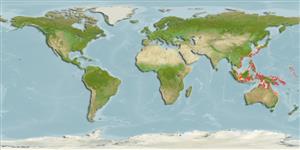Klassifizierung / Names
Namen | Synonyme | Catalog of Fishes(Gattung, Arten) | ITIS | CoL | WoRMS | Cloffa
>
Gobiiformes (Gobies) >
Gobiidae (Gobies) > Gobiinae
Etymology: Ancistrogobius: Name from Greek word 'agkistros' meaning fishhook and Gobius , a genus name of gobiine fish, in reference to the short, ventrally directed, spur-like preopercular spine; yoshigoui: Named for H. Yoshigou, who provided five paratypes and valuable information about this species.
Eponymy: Hidenori Yoshigou is (1998–present) a research zoologist and systematist with the environmental company, Chugai Technos, Hiroshima, Japan. [...] (Ref. 128868), visit book page.
Environment: milieu / climate zone / Tiefenbereich / distribution range
Ökologie
seewasser benthopelagisch; tiefenbereich 5 - 30 m (Ref. 84001). Subtropical
Western Pacific: Japan, Philippines, Indonesia and Papua New Guinea.
Size / Gewicht / Alter
Geschlechtsreife: Lm ? range ? - ? cm
Max length : 4.1 cm SL Männchen/unbestimmt; (Ref. 84001)
Kurzbeschreibung
Bestimmungsschlüssel | Morphologie | Morphometrie
Rückenflossenstacheln (insgesamt) : 7; Rückenflossenweichstrahlen (insgesamt) : 9 - 10; Afterflossenstacheln: 1; Afterflossenweichstrahlen: 9. This species is unique from its congeners by having the following characters: lacks a filamentous spine on the first dorsal fin (the third spine subequal in length to preceding spine); 19-20, typically 20 pectoral-fin rays; head and most of nape no scales, predorsal scales absent; pelvic fins fused medially with well developed connecting membrane and frenum; fifth segmented ray of pelvic fin 91.8-94.9% of preceding ray in length; below the eye faint, dusky blotches (not forming vertical bar); distal tip of first dorsal fin with a black blotch, wide, extending posteriorly to middle or more posterior part of third interspinal membrane; sensory papilla rows x^1 and x^2 not continuous, interrupted by row trp; sensory papilla rows trp extending dorsally to slightly above a longitudinal line through rows x^1 + x^2; anterior tip of sensory papilla row b extending or not to row 4 and well apart from row (Ref. 84001).
Body shape (shape guide): elongated; Cross section: oval.
Collected from sandy-mud or silt bottoms at depths of 5-30 m (Ref. 84001).
Life cycle and mating behavior
Geschlechtsreife | Fortpflanzung | Ablaichen | Eier | Fecundity | Larven
Shibukawa, K., T. Yoshino and G.R. Allen, 2010. Ancistrogobius, a new cheek-spine goby genus from the West Pacific and Red Sea, with descriptions of four new species (Perciformes: Gobiidae: Gobiinae). Bull. Natl. Mus. Nat. Sci., Ser. A, (Suppl. 4):67-87. (Ref. 84001)
IUCN Rote Liste Status (Ref. 130435: Version 2025-1)
Bedrohung für Menschen
Harmless
Nutzung durch Menschen
Tools
Zusatzinformationen
Download XML
Internet Quellen
Estimates based on models
Preferred temperature (Ref.
123201): 25.4 - 29.3, mean 28.7 °C (based on 903 cells).
Phylogenetic diversity index (Ref.
82804): PD
50 = 0.5625 [Uniqueness, from 0.5 = low to 2.0 = high].
Bayesian length-weight: a=0.00724 (0.00339 - 0.01546), b=3.10 (2.92 - 3.28), in cm total length, based on LWR estimates for this (Sub)family-body shape (Ref.
93245).
Trophic level (Ref.
69278): 3.2 ±0.3 se; based on size and trophs of closest relatives
Widerstandsfähigkeit (Ref.
120179): hoch, Verdopplung der Population dauert weniger als 15 Monate. (Preliminary K or Fecundity.).
Fishing Vulnerability (Ref.
59153): Low vulnerability (10 of 100).
🛈
